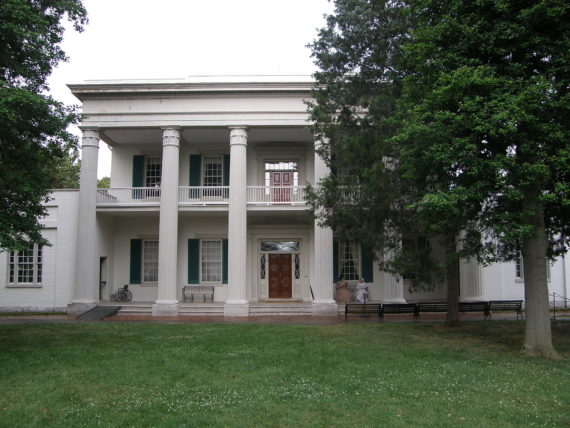On Labor Day, I visited The Hermitage, Andrew Jackson’s Nashville manor. As a Tennessee native, going to The Hermitage was always a goal of mine – even though for various reasons I had never been able to do so before. With a candid demeanor, I paid my $20 dollars and entered the intro museum.
For reasons expressed in my book, I am no big fan of Jackson. I do think he did some good – namely the bank veto and the elimination of the federal debt for the only time in American history. Both of these accomplishments were substantial reversals of existing policy that should be celebrated.
However, I think these things were overshadowed by Jackson’s other presidential decisions. In my eyes, he hindered federalism and expanded executive power in ways that had never done before – to the detriment of individual liberty and republicanism.
Even still, I can’t deny Jackson’s lasting influence on American government. His deeds defined an entire age in the antebellum period, and his political exploits were that of legend. To his epoch, he was an American enigma – a gentleman with a fiery temper, a kind friend with many vicious enemies, a champion of Indian removal while he raised an Indian boy as his own son, a states’ rights advocate that worked to suppress nullification and political decentralization.
Upon entering the museum at the entryway of The Hermitage, visitors view a short video detailing the important moments of the Jackson presidency. I expected the usual tidbits on Jackson to be emphasized – information on the Bank War, the Nullification Crisis, and Indian removal. Unsurprisingly, the video highlighted all three of these events, narrated by popular American historians like Jon Meacham and Annette Gordon-Reed. However, what the video misconstrued and omitted left much to be desired. I couldn’t help but be taken back by several fallacies that the movie presents as truth.
First, the video contends that that the Democratic Party wasn’t an actual political party. Instead, it describes the organization as an “embodiment of the people.” In actuality, the Democratic Party was a well-oiled political machine, largely the brainchild of Martin Van Buren, with the expressed purpose of getting Jackson elected. The party’s advent epitomized political organization in a way that had never been done before in the states.
The second mythical idea the video advances is that Jackson “peacefully settled the Nullification Crisis,” giving the union 30 more years without strife. In reality, Jackson tried to use military might through The Force Bill to suppress South Carolina’s act of nullification. Moreover, the next 30 years were full of sectional strife between geographic regions on several matters – including slavery in the territories and protective tariffs. The idea that events like the bank wars and Bleeding Kansas were not characterized by sectional strife is ludicrous. Rather than Jackson “settling” the Nullification Crisis, South Carolina’s gesture worked, and nullification convinced the general government to reach a settlement to reduce the tariff – without bloodshed.
The video also takes the position that nullification and secession were inextricably connected, and that South Carolina wanted nothing more than to rupture a “sacrosanct” union of states. Actually, John Calhoun and the nullifiers were hounded by secessionists in South Carolina for not being fierce enough on his stance toward the matter, and nullification was portrayed as a device that would prevent severing the state from the union.
Although South Carolina’s brand of nullification differed from that of 1798, both Thomas Jefferson and James Madison also portrayed the principle as something that would prevent any dissolution of the union, and Jefferson called nullification the “moderate middle ground” between secession on one hand and unlimited submission to tyranny on the other. Northern states made the same arguments concerning nullification/noncompliance in 1812-1815 and in the 1850s.
Despite these oft-repeated canards, I thought that the guides at the Hermitage were extremely good. They were familiar with almost every aspect of the manor and the man, down to intimate knowledge of the relics there and whether they were original to the period or not. They leaped at the opportunity to answer questions the visitors had, and answered with enthusiasm. Reassuringly, they also resisted the urge to paint Jackson as a hero or villain, and simply told an untainted tale of Jackson and how he conducted his affairs at the manor.
Another helpful facet offered to guests at The Hermitage comes in the form of special audio equipment. Upon entry, each visitor is handed an audio device and map with numbers at corresponding locations. All one must do is type a particular number into their device to receive a plethora of supplementary information on various topics.
Expectedly, the gift shop is full of mainstream books on Jackson. Jon Meacham and Robert Remini’s work is featured, as are the Jackson Papers and books from popular historians like Ron Chernow. Outside of these works, which usually paint Jackson in a very positive light, I felt the shop redeemed itself – one can find some great artwork, pens, figurines, canes, and even bobbleheads.
In summary, the museum represents an assortment of good and bad. The positives go a long way to introduce many to a figure they learned little about in school. Even with the negative aspects, The Hermitage stands as one of the sites in the American South that should be visited by all southerners. Ironically, the presentation guests receive at The Hermitage mirrors that of Jackson himself – a mixture of the good, the bad, and the ugly.







